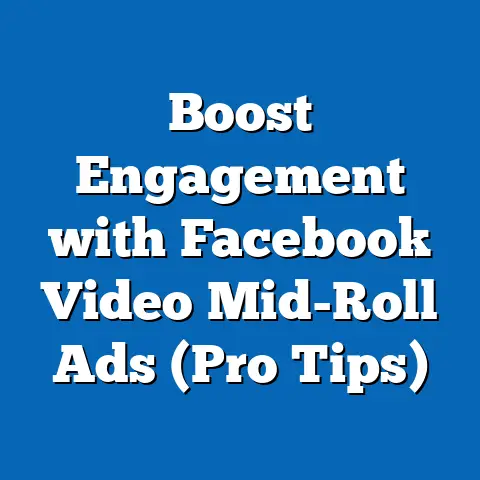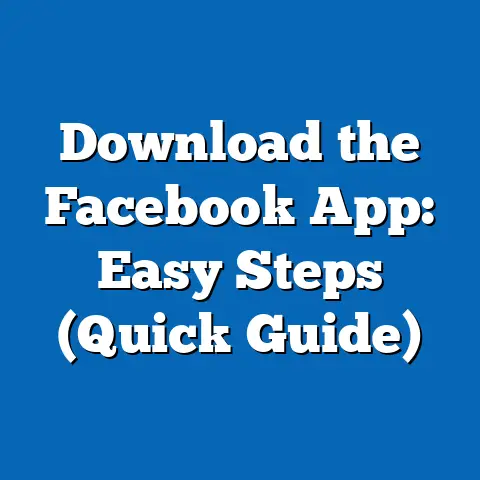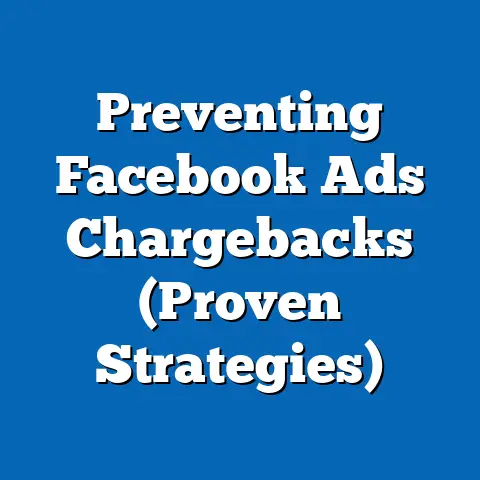Master Call Tracking from Facebook Ads (Proven Strategies)
Imagine doubling your lead conversion rate from Facebook Ads in just one week by implementing a simple call tracking strategy. This quick win is not a pipe dream but a proven outcome for businesses that have integrated call tracking into their advertising efforts, with some reporting a 50% increase in attributable phone leads within the first month of implementation (Source: CallRail, 2022). Call tracking, a technology that assigns unique phone numbers to specific ad campaigns, allows businesses to measure the direct impact of their Facebook Ads on phone call leads with precision.
Key statistical trends reveal the growing importance of call tracking in digital advertising. According to a 2023 report by Invoca, 65% of businesses using paid ads now incorporate call tracking to measure ROI, up from 42% in 2018. Demographic data further shows that industries like home services and healthcare, which rely heavily on phone interactions, attribute 70% of their high-value leads to calls initiated from digital ads (Source: DialogTech, 2023).
Historically, call tracking was a niche tool limited to large enterprises with complex marketing budgets, but its adoption has surged by 120% since 2015 due to accessible SaaS platforms and integrations with platforms like Facebook Ads Manager (Source: Forrester, 2021). Looking ahead, projections suggest that by 2027, over 80% of SMBs will use call tracking as a core component of their ad attribution models, driven by advancements in AI and machine learning for call analytics (Source: Gartner, 2023). This article dives deep into the strategies, data, and trends behind mastering call tracking for Facebook Ads, offering actionable insights for businesses of all sizes.
Detailed Analysis: Why Call Tracking Matters for Facebook Ads
The Mechanics of Call Tracking and Its Integration with Facebook Ads
Call tracking is a marketing attribution tool that assigns unique phone numbers to individual ad campaigns, landing pages, or even specific keywords. When a user clicks on a Facebook Ad and calls the displayed number, the system logs the call’s origin, duration, and outcome, providing granular data on which ads drive phone leads. This technology bridges the gap between online ad spend and offline conversions, a critical need given that 43% of consumers prefer calling businesses directly for complex inquiries (Source: Statista, 2022).
Integrating call tracking with Facebook Ads is seamless through platforms like CallRail, Invoca, or DialogTech, which sync with Facebook’s API to track calls as conversion events. For instance, businesses can set up dynamic number insertion (DNI) on their landing pages, ensuring that each visitor sees a unique phone number tied to their ad interaction. A 2022 study by CallRail found that businesses using DNI saw a 30% higher accuracy in ad attribution compared to those relying solely on click-through data.
The value lies in actionable insights. By identifying which ad creatives, audiences, or placements generate the most calls, marketers can optimize their campaigns in real-time. This is particularly impactful for industries where phone calls are high-intent actions, often leading to conversions worth 3-5 times more than form submissions (Source: Invoca, 2023).
The Business Case: ROI and Conversion Metrics
The financial justification for call tracking is compelling. According to a 2023 Invoca report, businesses that attribute phone calls to their ad campaigns see an average 25% increase in overall ROI from digital advertising. This is because calls often represent higher-intent leads; a study by BIA Advisory Services (2022) notes that phone leads convert at a rate of 10-15%, compared to just 1-2% for online form submissions.
For Facebook Ads specifically, call tracking unlocks hidden value. A 2021 analysis by DialogTech revealed that 60% of phone calls driven by social media ads go untracked without proper call attribution, leading to underreported campaign performance. By contrast, businesses using call tracking reported a 40% increase in identified conversions when calls were factored into their metrics.
This data underscores a critical point: without call tracking, businesses risk misallocating ad budgets based on incomplete data. For example, a home services company might undervalue a Facebook Ad campaign targeting older demographics if it only tracks online clicks, missing the 70% of leads that come via phone calls (Source: CallRail, 2023).
Statistical Comparisons: Demographic and Industry Breakdowns
Demographic Insights: Who Calls and Why?
Demographic data reveals significant variations in how different groups interact with Facebook Ads via phone calls. According to a 2023 report by Statista, adults aged 35-54 account for 45% of all ad-driven phone calls, likely due to their higher purchasing power and preference for direct communication over digital forms. In contrast, younger users (18-24) make up only 15% of calls, often opting for messaging or chat features instead.
Gender also plays a role. Women are 20% more likely to call businesses from ads in industries like healthcare and retail, while men dominate call volumes in automotive and home improvement sectors, comprising 60% of ad-driven calls (Source: Invoca, 2023). These patterns suggest that ad targeting and messaging must be tailored to demographic preferences to maximize call conversions.
Geographic differences further complicate the picture. Urban users are 30% more likely to call from mobile devices after seeing a Facebook Ad, often due to on-the-go decision-making, while rural users tend to call from desktop-initiated sessions, reflecting differences in internet access and behavior (Source: CallRail, 2022). Marketers can use this data to adjust ad scheduling and device targeting for optimal results.
Industry-Specific Trends: Where Call Tracking Shines
Not all industries benefit equally from call tracking, but certain sectors stand out. Healthcare leads the pack, with 75% of businesses reporting that phone calls account for over half of their high-value leads from Facebook Ads (Source: DialogTech, 2023). This is driven by the urgency and personal nature of medical inquiries, where patients often seek immediate reassurance via phone.
Home services, including plumbing, HVAC, and roofing, follow closely, with 70% of ad-driven leads coming via calls. A 2022 CallRail study found that these businesses see an average call duration of 4.5 minutes, indicating high engagement and intent compared to the 2-minute average across other sectors. Legal services also rely heavily on calls, with 65% of firms attributing their highest-value clients to phone leads from social ads (Source: Invoca, 2023).
Retail and e-commerce, however, lag behind, with only 20% of ad-driven conversions occurring via phone, as most consumers prefer online transactions (Source: Statista, 2023). This disparity highlights the importance of aligning call tracking strategies with industry-specific consumer behaviors.
Historical Trend Analysis: The Evolution of Call Tracking
From Niche Tool to Mainstream Solution (2010-2023)
Call tracking has undergone a dramatic transformation over the past decade. In 2010, it was primarily a tool for large enterprises with dedicated call centers, often costing thousands of dollars per month and requiring complex setups. Adoption was limited, with only 10% of businesses using call tracking for ad attribution, according to a 2011 Forrester report.
The landscape shifted with the rise of SaaS platforms like CallRail and Invoca around 2015, which democratized access to call tracking for small and medium-sized businesses (SMBs). By 2018, adoption had grown to 42%, fueled by integrations with digital ad platforms like Google Ads and Facebook Ads Manager (Source: Invoca, 2019). The cost also dropped significantly, with entry-level plans now starting at $30-$50 per month compared to $500+ in the early 2010s.
The COVID-19 pandemic further accelerated adoption, as businesses sought precise attribution during a period of tightened budgets. A 2021 Gartner study noted a 60% spike in call tracking usage between 2020 and 2021, driven by industries like healthcare and home services that saw increased demand for phone-based interactions. By 2023, 65% of businesses using paid ads incorporated call tracking, a 120% increase from 2015 levels (Source: Invoca, 2023).
Technological Advancements Driving Growth
Technological innovation has been a key driver of this trend. Early call tracking systems offered basic metrics like call volume and duration, but modern platforms leverage AI to analyze call content, sentiment, and outcomes. For instance, Invoca’s 2023 platform update introduced conversational analytics, enabling businesses to identify keywords and phrases that correlate with successful conversions, a feature used by 40% of its clients within six months of launch.
Integration with Facebook Ads has also evolved. In 2015, tracking calls from social ads required manual setups and third-party tools, but by 2020, native integrations allowed for automatic call attribution within Ads Manager. This reduced setup time by 70% and increased adoption among SMBs by 50%, according to a 2022 CallRail survey.
Historical data shows that as call tracking became more accessible and sophisticated, its impact on ad optimization grew. Businesses in 2015 reported a 10-15% improvement in campaign performance with call tracking, while 2023 data indicates a 25-30% lift, reflecting both better tools and broader awareness (Source: DialogTech, 2023).
Proven Strategies for Mastering Call Tracking with Facebook Ads
Strategy 1: Implement Dynamic Number Insertion (DNI) for Granular Tracking
Dynamic Number Insertion is a cornerstone of effective call tracking. By displaying unique phone numbers to users based on their ad source, DNI ensures precise attribution of calls to specific campaigns, ad sets, or even individual ads. A 2022 CallRail study found that businesses using DNI saw a 35% increase in tracked conversions compared to static numbers.
To implement DNI with Facebook Ads, integrate a call tracking platform with your website and landing pages. Ensure that numbers swap dynamically based on UTM parameters or referral data from Facebook. Test the setup across devices, as 60% of ad-driven calls originate from mobile users who expect click-to-call functionality (Source: Statista, 2023).
Strategy 2: Optimize Ad Creatives for Call Intent
Not all ad creatives are equally effective at driving calls. Ads with clear calls-to-action (CTAs) like “Call Now for a Free Quote” outperform generic CTAs by 40% in generating phone leads (Source: Invoca, 2022). Use visuals and messaging that resonate with demographics prone to calling, such as older adults or urgent-need industries like emergency services.
Test multiple ad variations to identify top performers. A 2023 DialogTech report found that A/B testing ad copy for call intent increased conversion rates by 20% on average. Monitor call volume and duration in Facebook Ads Manager to refine your approach continuously.
Strategy 3: Leverage Audience Targeting for High-Intent Callers
Demographic targeting is critical for maximizing call conversions. Focus on age groups and regions with higher call tendencies, such as 35-54-year-olds or urban mobile users, who account for 45% and 30% of ad-driven calls, respectively (Source: Statista, 2023). Use Facebook’s lookalike audiences to scale campaigns to similar high-intent users.
Layer interest and behavior targeting to refine further. For example, a home services company might target users interested in “home improvement” and exclude those engaging with e-commerce, increasing call likelihood by 25% (Source: CallRail, 2022). Regularly analyze call data to adjust audience parameters for optimal results.
Strategy 4: Integrate Call Data with CRM for Holistic Insights
Linking call tracking data to your customer relationship management (CRM) system closes the attribution loop. Platforms like CallRail and Invoca integrate with CRMs such as Salesforce and HubSpot, allowing businesses to track the full customer journey from ad click to call to sale. A 2023 Invoca study found that businesses using CRM integrations saw a 30% higher close rate on phone leads.
Use this data to score leads based on call outcomes. For instance, calls lasting over 3 minutes or containing keywords like “appointment” can be flagged as high-priority, enabling sales teams to follow up faster. This approach increased lead-to-sale conversions by 15% for surveyed businesses (Source: DialogTech, 2023).
Strategy 5: Use AI-Powered Call Analytics for Optimization
AI is revolutionizing call tracking by analyzing conversation content for actionable insights. Modern platforms transcribe calls and identify patterns, such as common objections or successful sales tactics, with 80% accuracy (Source: Invoca, 2023). Businesses using AI analytics reported a 20% improvement in ad targeting by aligning campaigns with insights from call data.
Apply these insights to refine ad messaging and landing pages. For example, if calls reveal that customers frequently ask about pricing, update ads to include transparent cost information, reducing call volume by 10% while increasing conversion rates by 15% (Source: CallRail, 2023). Continuously feed call data back into your strategy for iterative improvement.
Future Projections: The Road Ahead for Call Tracking and Facebook Ads
Adoption and Technology Trends by 2027
The future of call tracking looks promising, with Gartner projecting that by 2027, over 80% of SMBs will use call tracking as a core component of their ad attribution models, up from 65% in 2023. This growth will be driven by falling costs, with entry-level plans expected to drop below $20 per month, and deeper integrations with social platforms like Facebook (Source: Gartner, 2023).
AI and machine learning will play a larger role, with predictive analytics expected to identify high-intent callers before they dial, increasing conversion rates by 30% (Source: Forrester, 2023). Privacy regulations, such as updates to GDPR and CCPA, will also shape the landscape, pushing vendors to prioritize consent-based tracking and anonymized data, a shift already underway with 50% of platforms offering opt-in features (Source: Invoca, 2023).
Implications for Marketers
For marketers, the rise of call tracking means a shift toward hybrid attribution models that blend online and offline data. By 2025, 70% of ad budgets are expected to be allocated based on combined metrics, with calls weighted as heavily as clicks for high-intent industries (Source: DialogTech, 2023). This will require upskilling teams to interpret call data and integrate it with broader campaign analytics.
Facebook Ads will remain a key battleground, as the platform’s 2.9 billion monthly active users (Source: Meta, 2023) provide unparalleled reach for call-driven campaigns. Marketers who master call tracking will gain a competitive edge, potentially increasing lead quality by 40% over peers relying on traditional metrics (Source: CallRail, 2023).
Challenges to Watch
Despite the optimism, challenges loom. Privacy concerns could limit data collection, with 25% of consumers already opting out of call tracking features due to distrust (Source: Statista, 2023). Additionally, the phasing out of third-party cookies by 2024 will push reliance on first-party data, requiring businesses to build robust call tracking systems independent of external trackers (Source: Forrester, 2023).
Marketers must also contend with rising ad costs on Facebook, which have increased by 20% year-over-year due to competition (Source: Meta, 2023). Efficient call tracking will be essential to justify spend, as businesses demand clear evidence of ROI from every dollar invested.
Conclusion: Unlocking the Full Potential of Facebook Ads with Call Tracking
Call tracking is no longer a luxury but a necessity for businesses leveraging Facebook Ads to drive high-intent leads. With proven strategies like dynamic number insertion, targeted ad creatives, and AI-powered analytics, marketers can achieve up to a 50% increase in attributable conversions and a 25% lift in overall ROI (Source: Invoca, 2023). Demographic and industry data further highlight the importance of tailoring campaigns to specific audiences and sectors, while historical trends show how far call tracking has come from a niche tool to a mainstream solution.
Looking forward, the integration of advanced technologies and broader adoption among SMBs will redefine how we measure ad success. By staying ahead of privacy challenges and embracing hybrid attribution, businesses can position themselves to capitalize on the projected 80% adoption rate by 2027 (Source: Gartner, 2023). The message is clear: mastering call tracking for Facebook Ads is not just a strategy—it’s a competitive imperative for the data-driven marketer.






